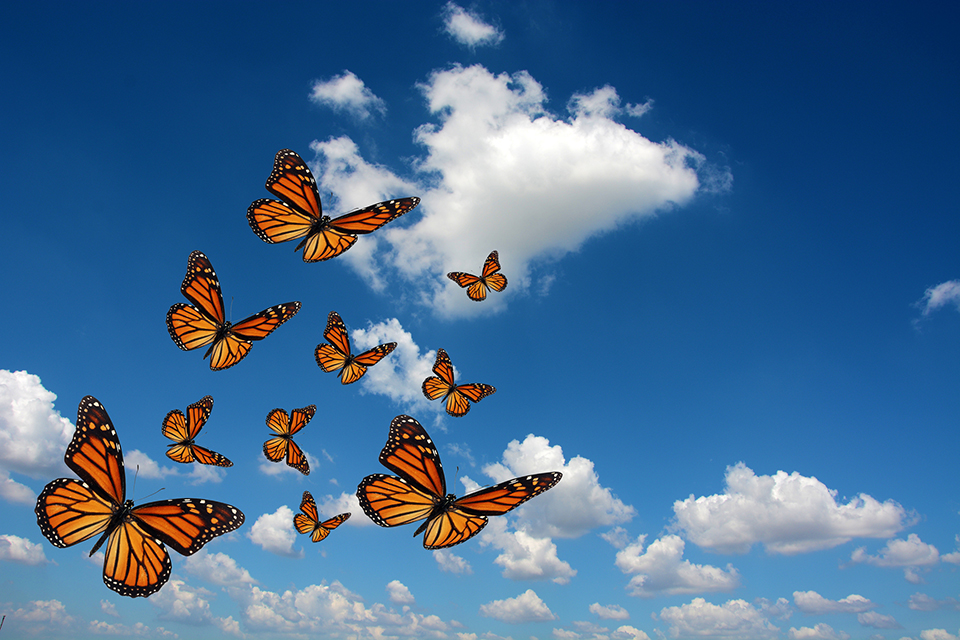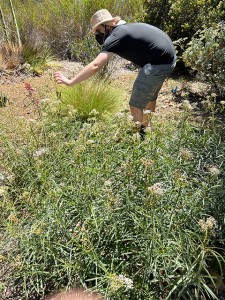CSUN Student Receives Grant to Increase Habitat for Butterfly, Other Pollinators

CSUN philosophy major Ethan Walsh has partnered with the Santa Ynez Band of Chumash Indians to improve pollinator habitats on Chumash ancestral lands. Their efforts earned $175,000 from the National Fish and Wildlife Foundation and its Monarch Butterfly and Pollinators Conservation Fund, as well as an additional $245,000 from the tribe. Photo by thawats, iStock.
With their striking orange wings laced with black lines and bordered with white dots, monarch butterflies and their annual migration south from the United States and Canada to California and Mexico have become the stuff of legend. But habitat loss threatens the future of not just the butterflies, but other pollinators essential to the nation’s ecosystems.
“We have to do something now, before it’s too late,” said California State University, Northridge philosophy student Ethan Walsh, a senior in CSUN’s College of Humanities.
Walsh, 25, of Woodland Hills, is grants program manager for Land Relief, a nonprofit organization that has partnered with the Santa Ynez Band of Chumash Indians to improve pollinator habitats on Chumash ancestral lands. Their efforts earned $175,000 from the National Fish and Wildlife Foundation and its Monarch Butterfly and Pollinators Conservation Fund, as well as an additional $245,000 from the tribe.

CSUN philosophy major Ethan Walsh collecting seeds from a native milkweed plant. Photo courtesy of Ethan Walsh.
Walsh and Land Relief — which was founded by his mother, Christina Walsh — are working with the Chumash to restore and improve habitats for monarch butterflies and other pollinators. They are planting pollinator hedgerows and seedlings at three sites on 210 acres of ancestral land in the Santa Ynez Valley. As a result, about 140 acres of habitat being improved.
“Creating space for pollinators on ancestral land provides a unique opportunity to improve the native habitat, enhancing natural pollinator corridors, which support the urgent migratory needs of the monarch butterflies along with the nectar and habitat needs of other native pollinators,” Walsh said.
The restoration efforts center around native milkweed, the only plant monarch butterflies will eat. Native milkweed has been rapidly disappearing due to increased land development and the widespread spraying of weedkiller pesticides.
Walsh and his mother have spent years collecting the seeds of milkweed plants native to the region. They harvest seeds from plants in local woodlands and from the dozens of plants they have growing in their backyard.
“You can find tropical milkweed in commercial nurseries, but it’s not native to the region and really isn’t environmentally friendly because it requires too much water,” he said. “Besides, native milkweed is what the monarchs are looking for when they’re migrating.”
The Walshes have collected 2 pounds of native milkweed seeds so far, and they aim to collect 7 pounds total. They are cultivating seedlings to plant in hedgerows — closely spaced shrubs or trees planted to form a barrier, or to mark a boundary — with other pollinator-friendly plants. The goal is to protect them from other aggressive plant species, and to ensure enough milkweed survives to provide sustenance to the monarch butterflies along their migratory route.
The idea for the hedgerows, Walsh said, was inspired by a CSUN course he took last year in philosophy of environmental science.
“I was looking at the different aspects of permaculture, aquaculture and pollinators,” he said. “Among the things I came across were hedgerows. It’s very common for farmers to use hedgerows to protect their crops. They usually have a very industrial look because they’re built on these giant plots of land.
“We’re looking at creating more natural, spiral extensions that go along the riverbeds, where milkweed and other pollinating plants might naturally be found — or where there are bunches of trees along the monarchs’ migratory route where they can be protected from harsh weather,” Walsh said. “We are trying to fill in the gaps caused by land development and commercial agriculture along the monarchs’ migratory route.”
Walsh and his mother are working closely with members of the Chumash tribe to identify the ideal areas on their land to plant the hedgerows. In addition to milkweed, the hedgerows will include other native plants that attract pollinators.
“In addition to repairing the gaps along the monarchs’ migratory route, we also hope to restore native vegetation that once populated the Chumash’s ancestral lands,” Walsh said.
While their work is concentrated on Chumash land, Walsh said, they hope that Mother Nature will lend a hand in helping to spread the seeds of native pollinator-attractive plants elsewhere.
“If we do this right, and establish the hedgerows in the right, pollinator-friendly places — along the river and near protective trees — we will have reestablished a key point along the migratory path, while at the same time restoring the lands to the way they once were before colonialism and rampant development,” Walsh said.
The project also includes the establishment of a teaching and demonstration site at the Chumash information center, so visitors can learn about habitat restoration efforts and perhaps take lessons learned and apply them in their own communities.
“We don’t want what we are doing to be kept a secret,” Walsh said. “We and the Chumash tribal leaders want to share so that others can learn from what we’re doing.”
He noted his work with the Chumash and his studies at CSUN have inspired him to pursue a doctorate in the philosophy of environmental science. “The one class I took a couple semesters ago just turned my world upside down and showed me what I wanted to do with my life,” he said.
Walsh said that for decades, environmental science and decisions regarding the environment were usually based on a singular perspective that reflected the desires of the dominant culture.
“One of my goals is to ensure that as many perspectives as possible are considered when it comes to decisions regarding the environment and environmental science,” he said. “We only have one planet, and we need to start caring for it properly.”

 experience
experience